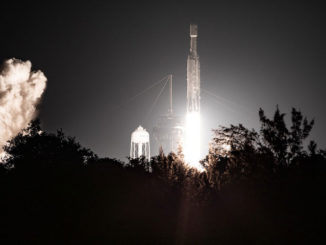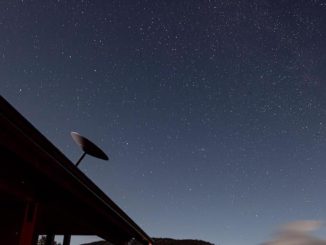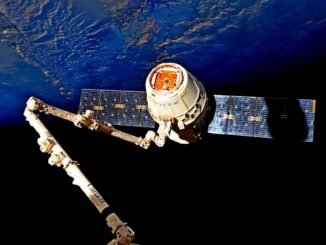
SpaceX said Tuesday it won’t perform a final countdown dress rehearsal this week for the giant new Starship launch vehicle, and could send the rocket — standing nearly 40 stories tall on its Texas launch pad — on an around-the-world test flight as soon as next week.
The launch is scheduled no earlier than Monday, April 17, but the schedule will depend on several factors, such as the completion of final checkouts on the rocket, weather conditions, and perhaps most visibly, the approval of a commercial launch license from the Federal Aviation Administration.
The 394-foot-tall (120-meter) rocket will be the largest and most powerful launch vehicle to ever fly when it lifts off from SpaceX’s privately-owned spaceport on the Texas Gulf Coast, exceeding the size and engine thrust of NASA’s Saturn 5 moon rocket and the Soviet Union’s ill-fated N1 launcher more than 50 years ago. It will also overtake NASA’s Space Launch System, which launched the Artemis 1 test flight around the moon on its mission in November.
Thirty-three methane-fueled Raptor engines, burning chilled methane and liquid oxygen, will drive the rocket off its launching stand with more than 16.5 million pounds of thrust at full power. If the rocket functions as intended, Starship will arc into space for more than an hour, bolting around the globe at nearly 5 miles per second before re-entering the atmosphere over the Pacific Ocean and splashing down north of Hawaii.
But the first flight of any rocket runs a higher-than-normal risk of a malfunction. The purpose of Starship’s integrated flight test is to gather data on the performance of the rocket, its engines, computers, and ground systems, helping engineers iterate designs for future tests, and eventually operational missions to deploy satellites into orbit and ferry cargo into deep space.
SpaceX launched prototypes of the Starship vehicle — which sits atop the Super Heavy booster on the fully-stacked rocket — on five high-altitude test flights in 2020 and 2021. On the final test flight in May 2021, the Starship vehicle launched to an altitude of about 33,000 feet (10 kilometers) and then successfully demonstrated its landing maneuver, involving a flip from horizontal to vertical orientation using a restart of its Raptor engines before settling onto its landing pad intact at the South Texas rocket complex.
With the sub-scale test flights behind them, SpaceX engineers turned their attention to building a new launch pad in Texas for the fully-stacked Super Heavy booster and Starship vehicle. Much of the work in the last year focused on ground tests of the Super Heavy stage, itself as tall as SpaceX’s workhorse Falcon 9 rocket, and the Starship vehicle assigned to the first launch aiming for space.
The Super Heavy for the integrated flight test is known as Booster 7 in SpaceX’s inventory of rockets. The Starship, with heat-resistant thermal protection tiles to shield it from the heat of atmospheric re-entry, is known as Ship 24.
Amid a series of fueling demonstrations with increasing complexity, SpaceX test-fired all six engines on the Ship 24 vehicle at the company’s seaside launch complex on Sept. 8. On Jan. 23, SpaceX filled the entire rocket — with Ship 24 on top of Booster 7 — with a full load of methane and liquid oxygen propellants for the first time.
Ground crews removed Ship 24 from the top of Booster 7 before a test-firing of 31 Raptor engines on the Super Heavy booster Feb. 9. The static fire test set set a record for the most rocket engines to ignite at once on a single vehicle. Two of the 33 engines did not fire, and the test only throttled the engines to their 50% power level.
“In addition to the testing of Starship’s upper stage, the team has conducted numerous tests of the Super Heavy rocket, which include the increasingly complex static fires that led to a full-duration 31 Raptor engine test — the largest number of simultaneous rocket engine ignitions in history,” SpaceX said.
SpaceX rolled Ship 24 and Booster 7 back to the company’s factory for final checks inside one of multiple hangers that have risen from the barren tidal flats of South Texas some 2 miles (3 kilometers) inland from the launch pad. Meanwhile, teams at the launch site beefed up the launch mount stainless steel armor to protect it from the heat blast from the Super Heavy booster’s Raptor engines.
Earlier this month, the vehicles returned to the launch site and were stacked together on the launch mount April 5. Ship 24 is expected to be removed from Booster 7 once more later this week to allow technicians to complete arming of the flight termination system, the destruct charge that would be activated if the rocket veers off course in flight and threatens people.
Elon Musk, SpaceX’s founder and CEO, has said the fully integrated test flight of the Starship launch vehicle is “trending towards near the end of third week of April.”
Advisories issued to mariners and posted on the FAA’s operations plan advisory indicate the daily launch window at SpaceX’s South Texas facility, known as Starbase, opens at 7 a.m. CDT (8 a.m. EDT; 1200 UTC). The launch site is located east of Brownsville, Texas, a few miles north of the U.S.-Mexico border at a place called Boca Chica Beach.
SpaceX said the launch schedule hinges on regulatory approval by the FAA, which licenses commercial launch and re-entry operations for U.S. companies. The company said Tuesday that it will forego a final launch day dress rehearsal, which would have included loading methane and liquid oxygen into the two-stage launcher, just as they will be pumped into the vehicle during the real launch attempt.
“Teams are focused on launch readiness ahead of Starship’s first integrated flight test as soon as next week, pending regulatory approval,” SpaceX tweeted Tuesday.
The FAA has said the Starship launch date’s appearance on the agency’s operations website “should not be not be interpreted as an indicator that a determination to issue a license has been made or is forthcoming.
“The agency will only make a determination after SpaceX meets all safety and other regulatory requirements,” an FAA spokesperson said.
The FAA announced last year that it will require SpaceX to take more than 75 actions to reduce the environmental effects of flying its Starship rocket from South Texas. But not all of the mitigation steps are required before the FAA issues a commercial launch license to SpaceX for the first Starship orbital test flight.

SpaceX released new details about the upcoming test flight on the company’s website Tuesday.
“This will be the first flight test of a fully integrated Starship and Super Heavy rocket, a fully reusable transportation system designed to carry both crew and cargo to Earth orbit, help humanity return to the moon, and travel to Mars and beyond,” SpaceX said. “With a test such as this, success is measured by how much we can learn, which will inform and improve the probability of success in the future as SpaceX rapidly advances development of Starship.”
After clearing its nearly 500-foot-tall launch pad tower, Super Heavy and Starship will steer on a trajectory east from Starbase over the Gulf of Mexico. The rocket will surpass the speed of sound and maximum aerodynamic pressure in less than a minute, when Starship will endure the harshest structural loads of its ascent into space.
SpaceX said completion of each milestone is not required to achieve a successful test flight. “But each milestone completed will certainly make for an exciting test,” the company said.
The engines on the Super Heavy booster will shut off nearly three minutes into the flight, allowing the booster stage to drop away from the Starship upper stage. Then the Raptor engines on the Starship vehicle will ignite, firing for the first time in the airless void of space to begin a planned six-and-a-half minute burn to accelerate to a speed close to orbital velocity.
Starship’s orbit is expected to be elliptical, or elongated in shape, with a high point, or apogee, in space and a low point, or perigee, at an altitude inside of Earth’s atmosphere.
After separating from the Starship vehicle about three minutes into the flight, the Super Heavy booster will reignite some of its 33 engines to cancel out its downrange velocity for a “boost-back” burn. Falling toward the Gulf of Mexico, the rocket will be programmed to light a subset of its engines again just before reaching the sea to slow for a controlled splashdown.
The Starship vehicle will coast around the world, flying over the Straits of Florida, the Atlantic Ocean, Africa, the Indian Ocean, Indonesia, and the Pacific before a scorching re-entry into the atmosphere north of Hawaii. SpaceX hopes to gather data during the ship’s re-entry, but the mission profile published by the company Tuesday does not indicate the vehicle will fire its engines to slow down before impact in the Pacific.
Both stages of the Starship launch vehicle are designed to be fully reusable, a step forward from SpaceX’s partially reusable Falcon 9 and Falcon Heavy rockets, which require brand new upper stages on each flight.
SpaceX’s concept for recovering the Super Heavy booster involves catching it with articulating “chopstick” arms on the 479-foot-tall (146-meter) launch tower. The Starship will also use its engines to return through the atmosphere and land back on Earth, or reach the surfaces of other planetary bodies like the moon or Mars. The first Starship orbital test flight, however, will not include any recovery and reuse attempts.
“SpaceX’s Starship spacecraft and Super Heavy rocket – collectively referred to as Starship – represent a fully reusable transportation system designed to carry both crew and cargo to Earth orbit, the moon, Mars and beyond,” SpaceX says on its website. “Starship will be the world’s most powerful launch vehicle ever developed, with the ability to carry up to 150 metric tonnes to Earth orbit reusable, and up to 250 metric tonnes expendable.”
SpaceX wants to use the Starship vehicle to launch the company’s Starlink internet satellites, flying heavier, next-generation versions of the broadband relay stations than the spacecraft now being launched by the smaller Falcon 9 rocket. An animation released from SpaceX showed the company’s concept for deploying Starlink satellites from a Starship vehicle in orbit, using a mechanism that works like a giant Pez dispenser.
SpaceX has also won a $2.9 billion contract with NASA to develop the Starship into a human-rated lander for the agency’s Artemis moon missions. A moon derivative of the Starship, assisted by Starship refueling tankers, will be utilized for a lunar landing with astronauts, an event NASA says could happen no earlier than 2025. SpaceX also has a deal with Japanese billionaire Yusaku Maezawa to send a team of private citizens around the moon on a Starship flight.
Flights of the Starship beyond low Earth orbit will require the still-untested in-orbit refueling capability SpaceX is developing for the new-generation rocket.
Musk has said SpaceX intends to use the Starbase facility in Texas as a test site for the Starship program. The company is building a second Starship launch pad at NASA’s Kennedy Space Center in Florida, with plans to construct more launch sites in the future, eventually building up to a capability to launch multiple Starship flights per day. With rapid reuse, SpaceX aims to reduce costs and give customers unprecedented access to space.
A major step in making this future a reality could happen next week in Texas’s Rio Grande Valley.
“Success is far from certain, but excitement is guaranteed,” Musk tweeted earlier this year.
Email the author.
Follow Stephen Clark on Twitter: @StephenClark1.



